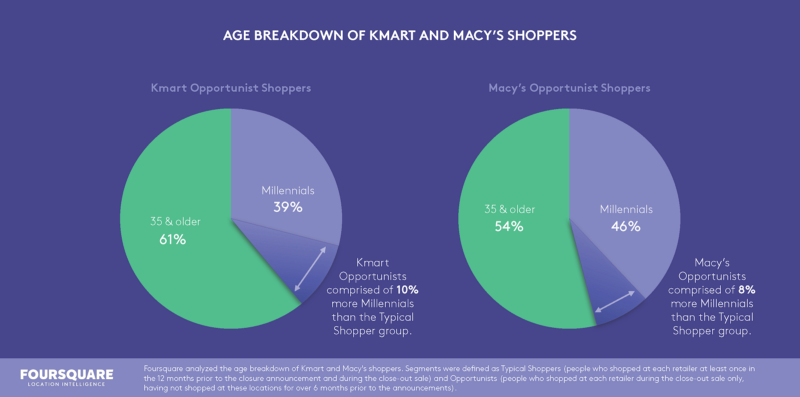Data: Store closings generate new shopping patterns, especially among Millennials
Future of retail involves fewer stores, which become "product playgrounds."

Traditional retailers are closing stores as a result of changing consumer shopping patterns and, in some cases, weaker than expected holiday sales. Macy’s, Kmart, The Limited and others have announced closings. In fact The Limited is closing all 250 of its physical retail locations, hoping to remain viable as an ecommerce-only brand.
Yesterday, Foursquare released findings on what happens when stores close and how it impacts retail brands and their competitors. The location-data company discovered the following from analyzing foot-traffic and store visitation patterns in the run-up to and aftermath of the closings of Kmart and Macy’s locations.
- Millennials flock to store-closing sales.
- Store loyalists are willing to travel farther to preferred retail brands following closings.
- Competitors must wait several months but then see a bump in foot traffic.
Foursquare found that Millennials comprised a higher percentage of in-store shoppers than the “typical shopper” profile at Macy’s and Kmart after store closings were announced. These were “opportunists” seeking to take advantage of aggressive discounting.
This speaks to Millennials’ interest in deals. It also suggests that a retailer might be able to “convert” Millennials into more regular shoppers at remaining stores with thoughtful promotion, an improved user experience and perhaps loyalty programs.

Foursquare found that retail loyalists were willing to travel to store locations farther away. “Our analysis found that on average, these displaced but loyal consumers were willing to travel an additional 4.3 miles to visit the next closest open Kmart, almost doubling the distance they were traveling in the past.”
Finally, competing retailers in the areas affected by store closures might actually see short-term store traffic drops, presumably because of local shoppers are taking advantage of discounts. However, in the longer term, they stand to gain shoppers.
There’s a seeming contradiction here, though it may be explained by shopper segmentation. On the one hand, the data show that shoppers will go further to their favorite stores — but they may also be lured away by competitors over time. The explanation may reside in the distinction between casual shoppers and loyalists.
Slice Intelligence previously reported that Amazon was responsible for 43 percent of US ecommerce revenue in 2016. Many analysts have attributed post-holiday store closing announcements to the so-called “Amazon effect.” However, Euclid Analytics CEO Brent Franson says store closings are about right-sizing physical retail for an omnichannel era.
“We’re over-stored,” explained Franson in an earlier interview. “In the past you could only buy things in physical stores; the way to grow was by adding locations.”
Franson says that a large store footprint is no longer required and maintaining stores is expensive. He points out, however, that stores are still critical for multiple reasons, including to support online sales. Franson cited third-party data showing that when stores disappear, it hurts online sales, too. This will be a major problem for The Limited.
I asked Franson how he would fix physical retail. He told me that retailers need to pursue an “intelligent reduction of store footprint that takes an agnostic view of where the purchase happens.” Stores should become “product playgrounds,” where people can feel and touch products and get help from live sales and customer service reps.
“The human element really matters,” Franson observed. “We’re too quick to dismiss humans and automate things.” People help build trust and can significantly improve the customer experience. “The store experience also needs to become much more personalized,” he added.
Contributing authors are invited to create content for MarTech and are chosen for their expertise and contribution to the martech community. Our contributors work under the oversight of the editorial staff and contributions are checked for quality and relevance to our readers. MarTech is owned by Semrush. Contributor was not asked to make any direct or indirect mentions of Semrush. The opinions they express are their own.
Related stories
New on MarTech